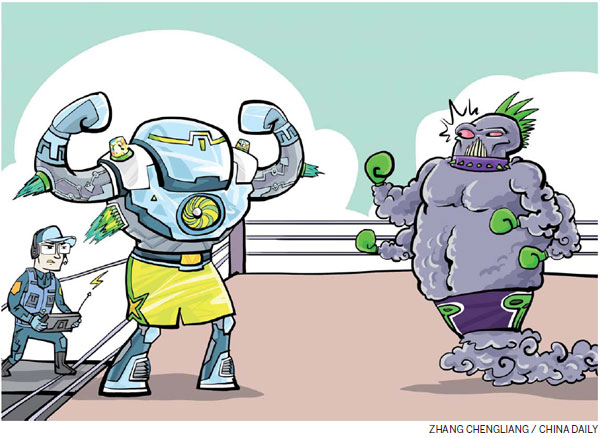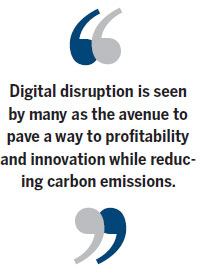Digital disruptors key to lower carbon
Updated: 2015-12-18 09:19
By Ynse de Boer and Li Guanghai(China Daily Europe)
|
|||||||||||
Companies are not waiting for global agreements but adopting transformations using new technology
Among those holding their breath before the United Nations Climate Change Conference reached an agreement in Paris on Dec 12 to limit carbon emissions were corporate leaders anxious to understand the implications for their businesses in the near future.
For China, with its strong national resolve to build the largest low-carbon economy in the world, the outcome was music to the ears of many green investors. But a large portion of industries view compliance with the outcomes as direct pressure and costly obligations.

For instance, China's coal industry is already struggling with a dramatic downturn amid sluggish prices. Overcapacity and shrinking demand, resulting from the transition to lower-carbon alternatives, has resulted in nearly 80 percent of these companies reportedly being challenged by deficits. Even in China's colossal logistics industry, with its growth tied to the prosperity of e-commerce and previous economic expansion, there are worries about new operational costs associated with truck fleet compliance with the country's emissions regulations.
Historically, every 1 percent increase in global GDP led to a 0.5 percent rise in carbon dioxide emissions. To many it seems unimaginable to decouple economic gains from emissions considered inevitable. But it is possible. In addition to China's aggressive investment in renewables and electrification, the country is actually pretty close to the key: Internet Plus (digitization of industries by mobile Internet), Internet of Things (Internet-connected products), big data analytics, cloud computing and other smart technologies.
Digital disruption is seen by many as the avenue to pave a way to profitability and innovation while reducing carbon emissions. In fact, our research finds that digital technology can offset all new emissions worldwide over the next 15 years. By applying digital technology and moving to low-carbon models in a range of industries, companies around the world can share the estimated $11.4 trillion of new value by 2030. That prize of low-carbon transformation via digital technology nearly equals China's current GDP, and is a welcome alternative to paying the significant costs for complying with tighter emissions rules.
Digital technology is so capable of offsetting CO2 emissions that it has great potential to decouple emissions growth from economic growth, according to research by Accenture, the management consulting and technology services company, carried out with the Global e-Sustainability Initiative, a consortium of global information, communication and technology companies.
Consider areas like transportation and logistics, manufacturing, agriculture and energy. Digital technology drives down carbon and enhances competitive positioning in each of them.
In transportation and logistics, it does so through faster, cheaper and safer mobility, real-time traffic management, smarter logistics, and intelligent lighting. In manufacturing, it occurs with virtual manufacturing, customer-centric production and circular supply chains. In smart agriculture, use of techniques like geographic mapping, machine-to-machine connectivity and data analytics drives water and energy efficiencies to boost crop yields, reduce food waste and ease access to markets.

And in the electricity sector, digital technology will enable the integration of renewables like solar and wind on the electricity grid, improving the efficiency of transmission and passing those savings to customers. This unprecedented scale of digital disruption makes low-carbon business opportunities possible - opportunities that weren't feasible five to 10 years ago.
To capitalize on the opportunities, Chinese companies hoping to unleash digital technology to combat emissions challenges will need to rethink their businesses on a fundamental level or risk losing out. They need to grasp the need for increasingly blurred industry boundaries because the biggest disruption takes place at the intersection of previously disconnected disciplines.
They also need to understand that digital technology is expanding companies' ability to reach new customers, allowing startups to scale low-carbon ideas to work out previously unsolved problems. Consider the Nest Learning Thermostat, which helps consumers understand and control home energy use, a popular consumer choice in the West. Or think of the Chinese home appliances manufacturer that achieved a strong market position with its innovative solar-inverter air conditioner that runs solely on solar energy, getting rid of power bills from the traditional grid.
Our researchers who explored successful cases in digital carbon disruption find that three business models have emerged as leading practices: the optimizer, the enabler and the transformer.
Optimizers: These companies work to improve the efficiency of existing operations or reduce costs. Of the potential $11.4 trillion to be generated by 2030 from the move to low carbon, $4.9 trillion would be the result of cost-saving opportunities. Typical goals include improved value chain connectivity and creating more visibility to reduce waste. An example would be a delivery company that combines advanced technology with dynamic route planning in its vehicles to reduce carbon emissions while generating cost savings.
Enablers: As the name implies, these companies develop the technology and infrastructure that support innovative approaches. One good example is British Telecom, which joined forces with the Open University to establish an app that tells drivers the location of open parking spaces. One town in the UK that tested the app saved at least 105 million pounds ($159 million; 145 million euros) that would have gone to building parking areas. Traffic congestion was cut by 50 percent, and fuel use and vehicle emissions were reduced.
Transformers: They create radically new offerings and entirely new markets while eliminating resource dependency. Transformers are changing incumbent businesses to low-carbon business models by digitizing customer offers and channels. There are a host of well-known examples like Uber, Airbnb and Car2go, which have all established sharing platforms to enable new, lower-carbon business models.
Leading companies are not waiting for the Paris summit's goals to be translated into specific industry regulations defining emissions cuts. Instead, they are adopting large-scale transformations in production, services and consumption thanks to the powers of digital technology. In the process they are causing carbon disruption. It's better for the planet and better for business. While China pushes reforms to improve its productivity with more sophisticated supply-side economics, digital carbon disruptors are expected to multiply in its business community.
Ynse de Boer is a managing director of Accenture Strategy's Sustainability Services. Li Guanghai is a managing director of Accenture Strategy in Greater China. The views do necessarily reflect those of China Daily.
(China Daily European Weekly 12/18/2015 page10)
Today's Top News
Xi calls for shared future in cyberspace
China successfully launches its first dark matter satellite
China becomes shareholder in European bank
Jeb Bush calls Trump a 'chaos candidate'
French report stresses China's growth offers new opportunities
Reasonable economomic growth rate targeted
French far-right fails to win any regions
Obama says anti-IS fight continues to be difficult
Hot Topics
Lunar probe , China growth forecasts, Emission rules get tougher, China seen through 'colored lens', International board,
Editor's Picks

|

|

|

|

|

|






